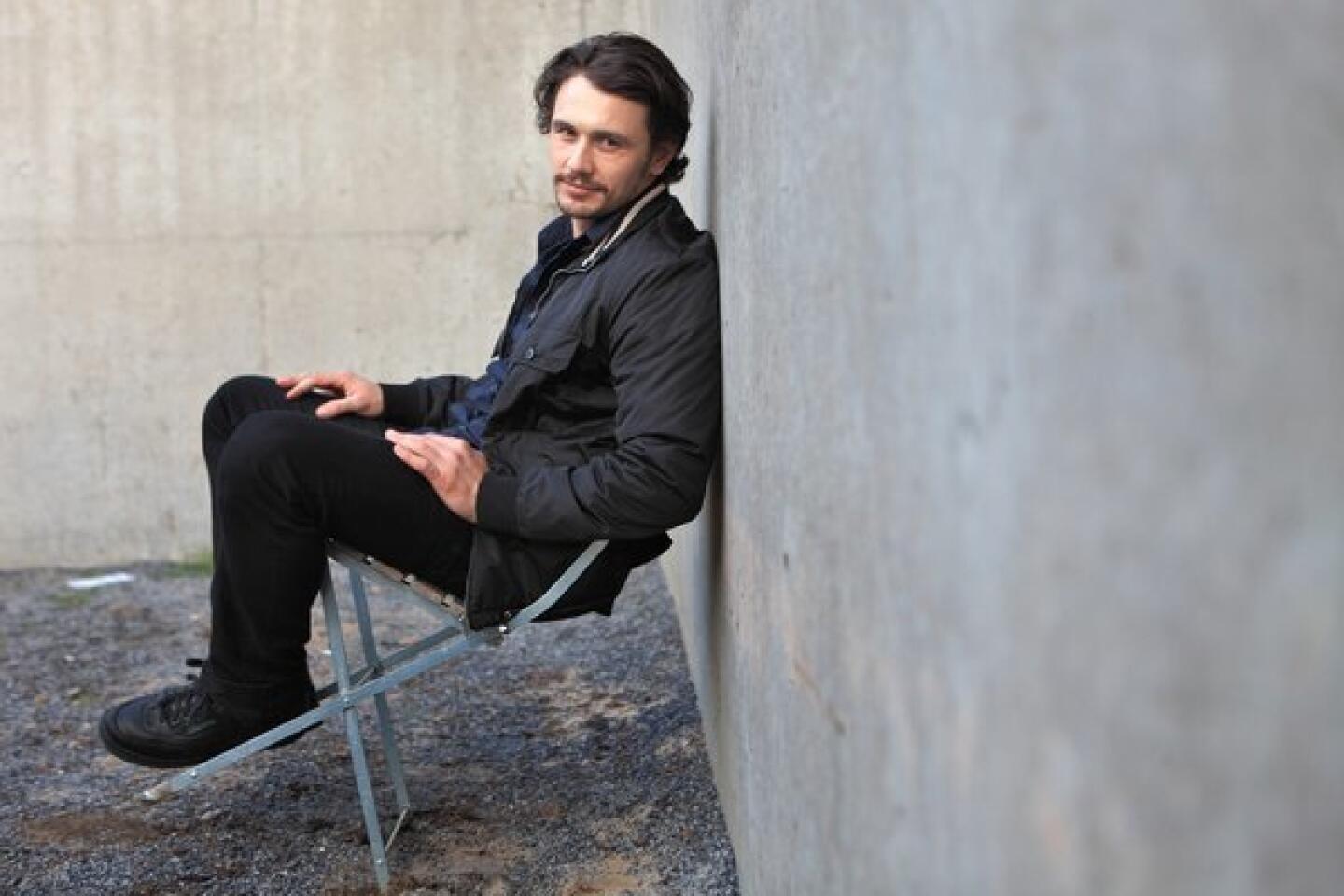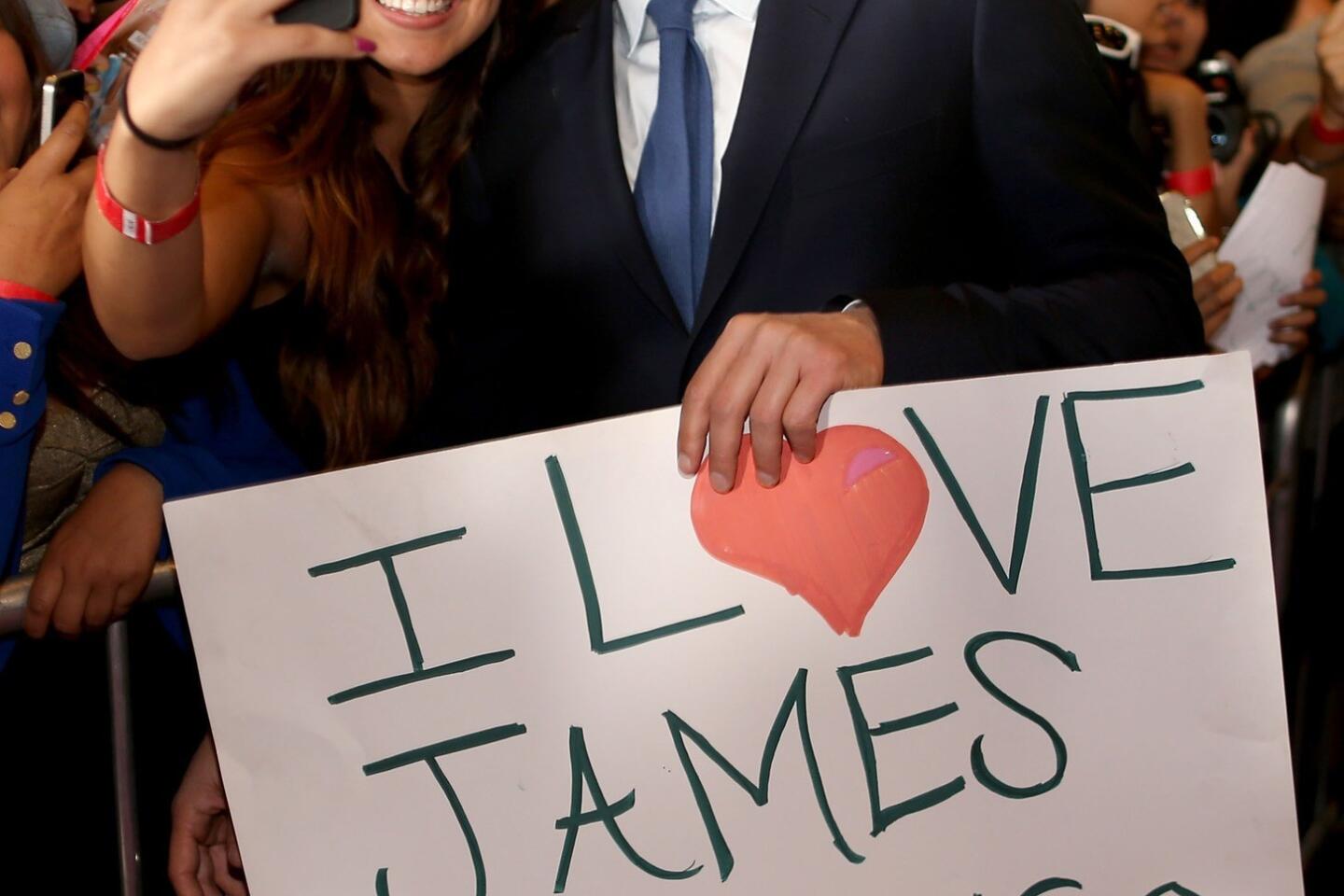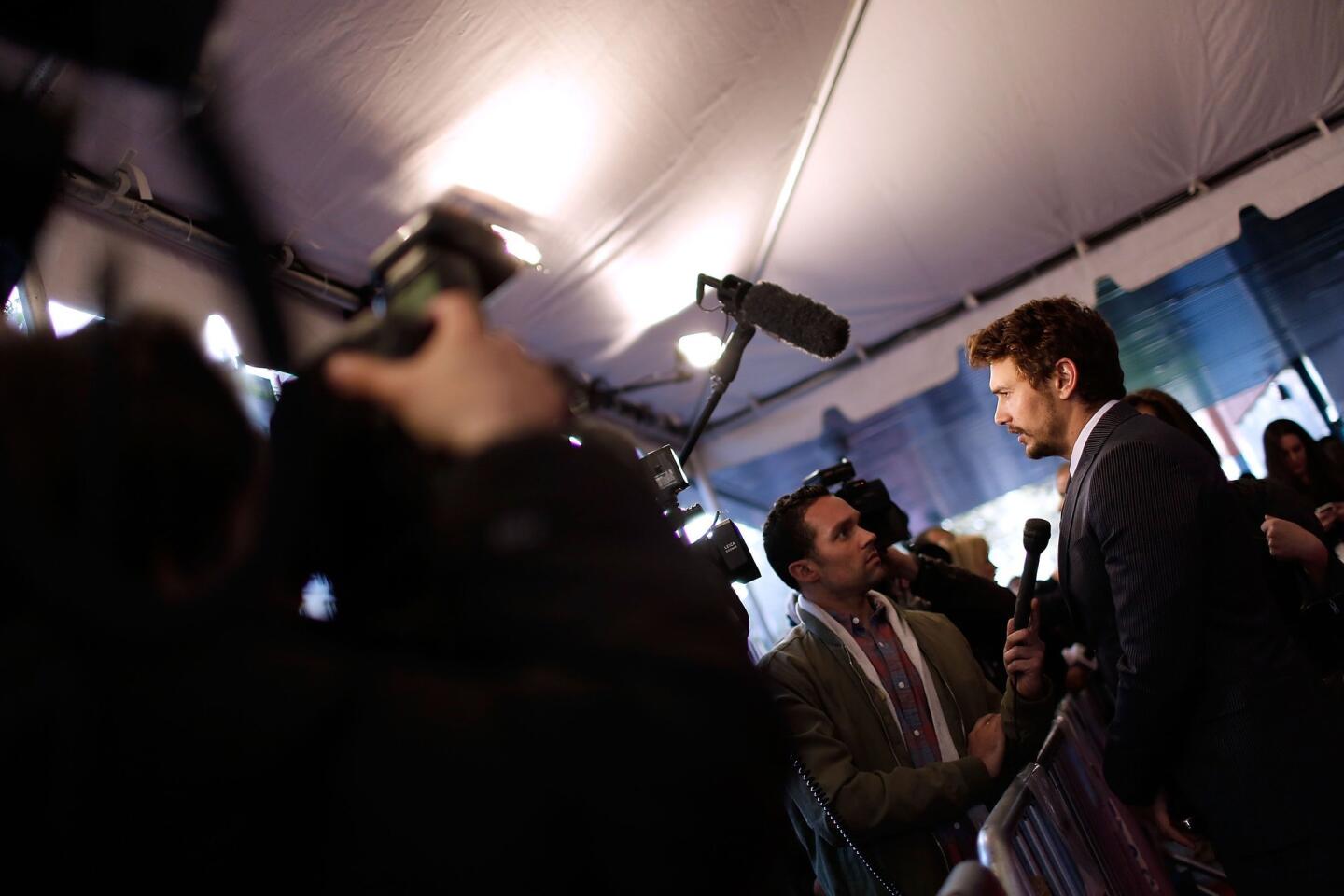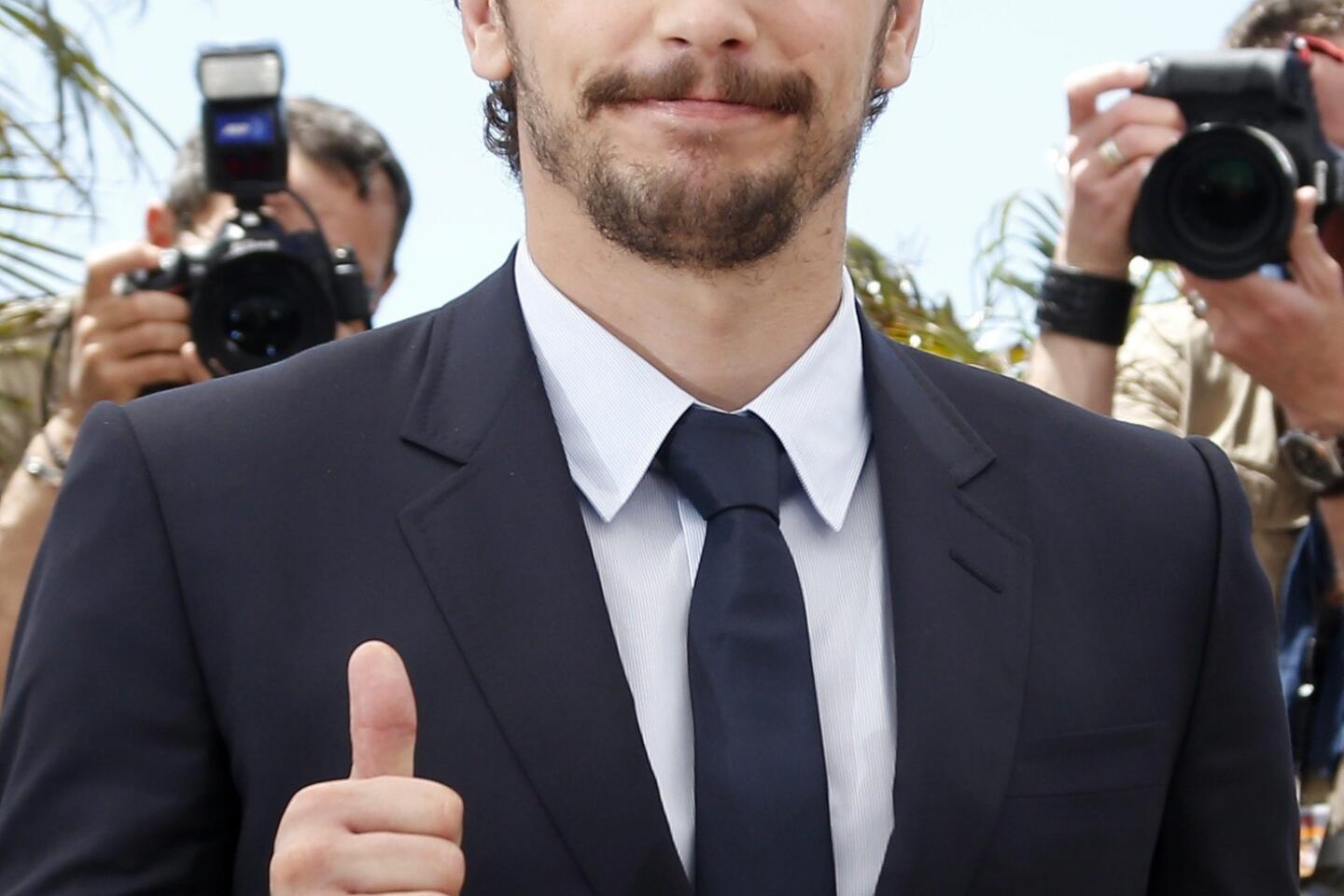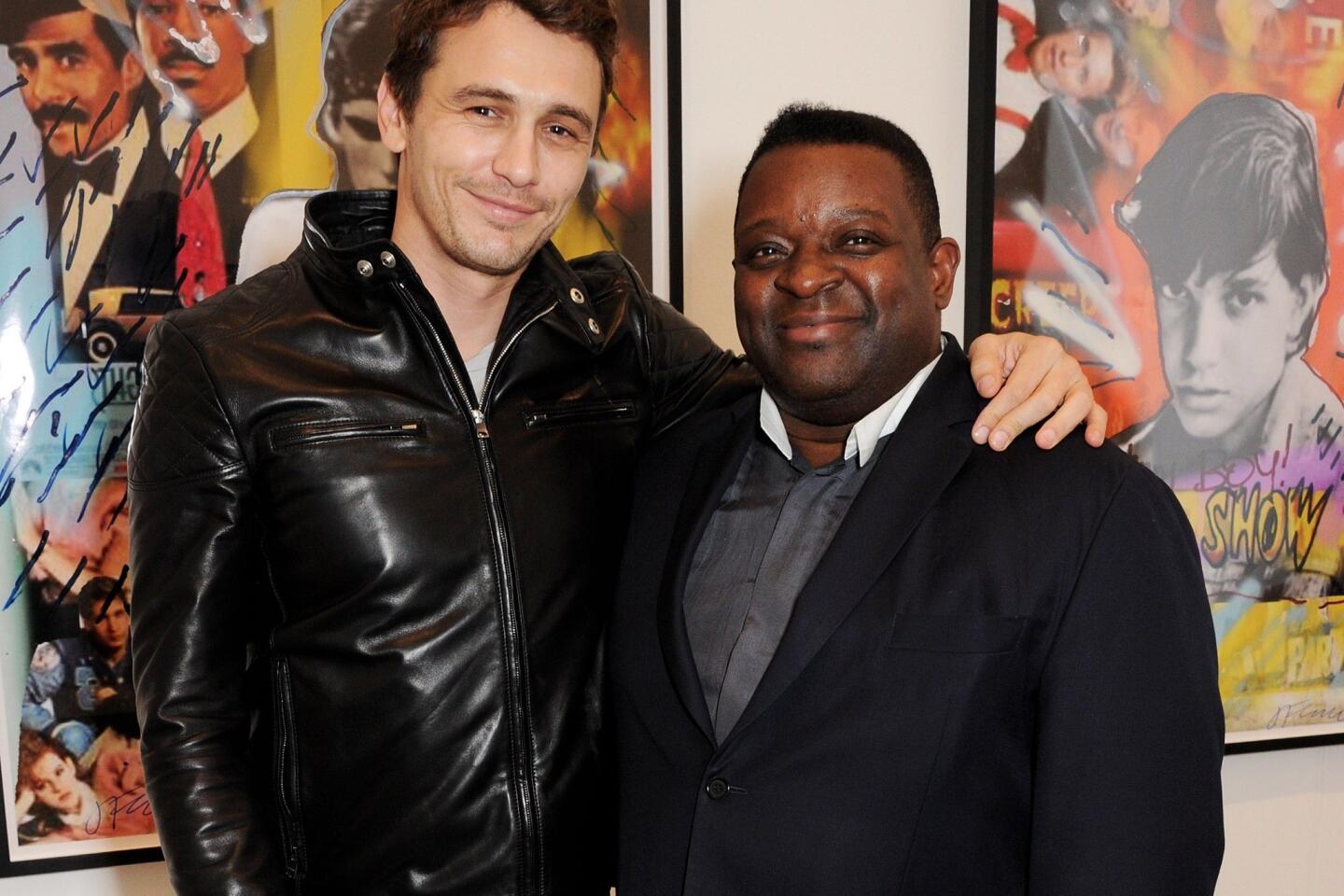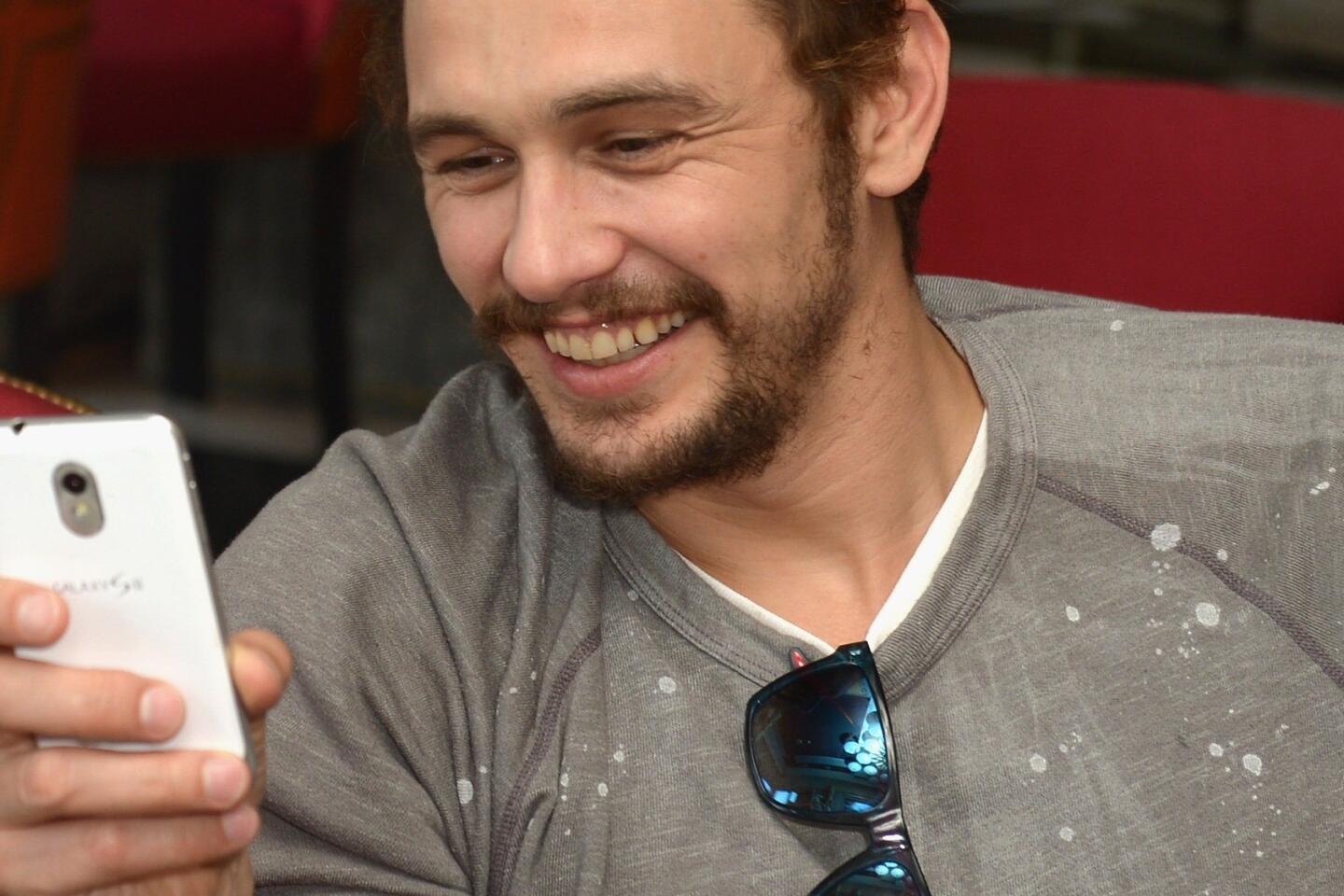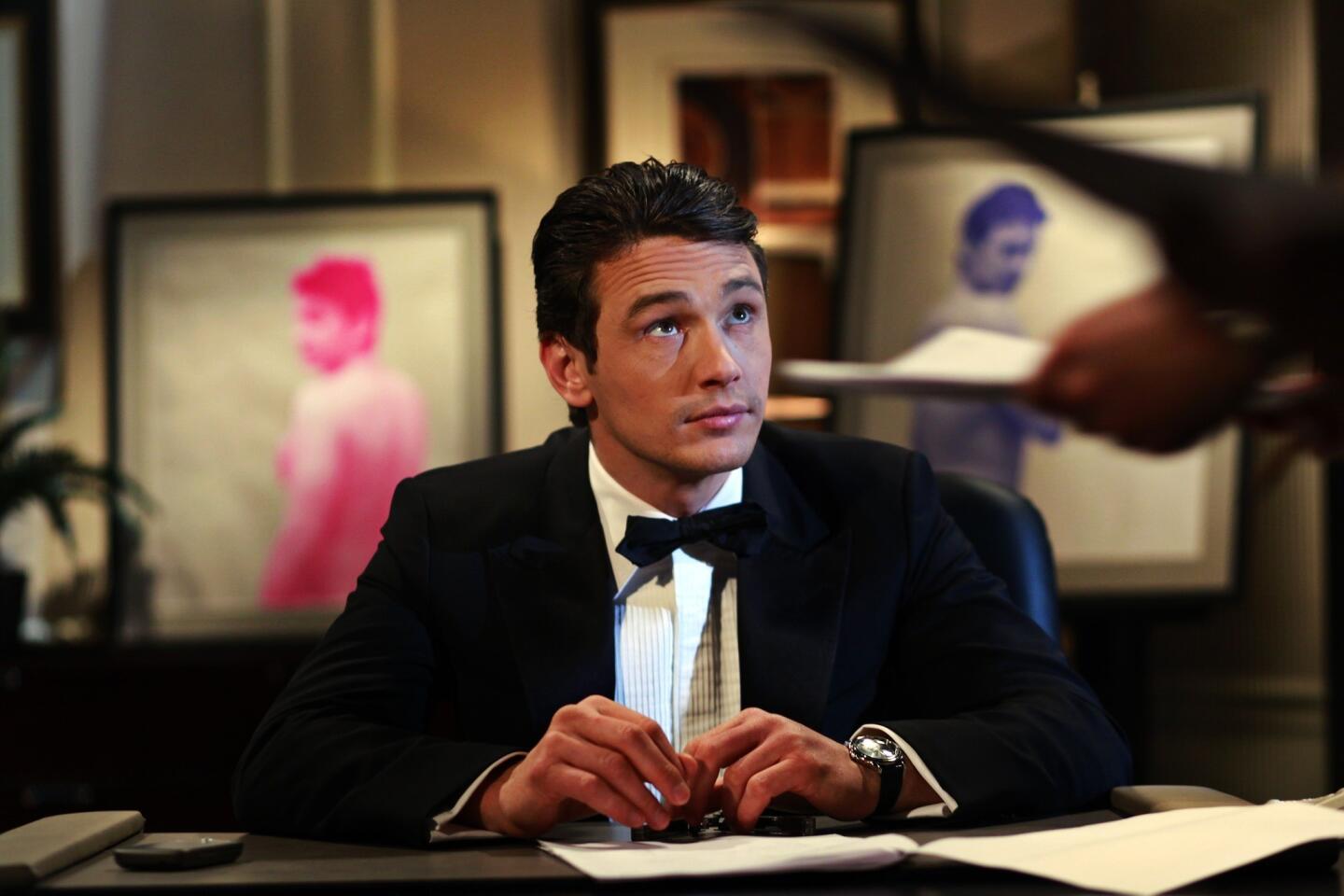For ‘This Is the End’s’ James Franco, it never really seems to be
- Share via
The snow is piling up on the streets of small-town Utah, and James Franco is talking about sex.
He is talking about sex in the way James Franco talks about sex: as a narrative tool, as a humanizing mechanism, as a way to help us understand academic differences between film and literature.
“We’ve been using violence as a storytelling device for decades, but we’ve only just begun to use sex that way instead of as simply something to shock,” he says, responding to a straightforward interview question with a disquisition on sexuality and film. Despite Franco’s charm and disheveled good looks, there is something clinical, earnest, unsexy about him. Hearing him talk about sex is like hearing one of the world’s great chefs talk about fine food and feeling no discernible appetite.
PHOTOS: The many faces, and places, of James Franco
The previous evening, Franco had shown his documentary “Kink,” about a fetish website, to a midnight audience at the Sundance Film Festival. The audience was uncomfortable, in a way that midnight Sundance audiences are seldom uncomfortable. Watching them from the back of the theater, Franco found himself surprised. But as he reflects on it now, he does not primarily see in the audience’s reaction a comment on sexuality. He sees a difference between the novelistic and the cinematic.
“Everybody likes to talk about sex, but when you put it on film it’s somehow different,” he says, professorially. “I was thinking at that moment: All the ‘Fifty Shades of Grey’ readers? This is what you’re reading about.”
In the last decade, Franco has created a rich set of personalities on-screen — as the Emerald City wizard, as the “Pineapple Express” pot dealer, as “127 Hours’” quixotic hiker, as “Spider-Man’s” Harry Osborn, as Harvey Milk’s boyfriend. He has created them so richly that he has joined the elite ranks of actors who have the chance to create a rich personality off-screen. But for James Franco that is not enough. For James Franco, there always must be a Francian twist.
And so in “This Is the End,” the Seth Rogen-directed apocalypse comedy hit in theaters, he plays, as one character calls him, a “pretentious … nerd,” inclined to windy digressions about art and philosophy. He is named James Franco and looks like James Franco and seems to act like James Franco and lives in a house said to be owned by James Franco, where he hangs his own painterly odes to Rogen and James Franco. But he is not James Franco.
PHOTOS: James Franco - Career in pictures
For perhaps the first time we have an actor who in real life has winkingly created a movie-worthy character, and then in the movies has created a character who winks back to his real life. There are other actors in “This Is the End” playing a distorted version of themselves. But Franco is playing a distorted version of the public character he created, which is itself a distortion of his real self.
Which makes for a lot of distortion and a need for headache medicine.
Other stars have also moved between big and small projects, and some have side gigs in music or writing. But few have done it so prolifically or so aggressively. And none have done it with this degree of meta-flair. Perhaps that’s why, though Franco is ubiquitous on movie marquees and Twitter feeds, it is the character of James Franco we mostly see and why we know so comparatively little about his personal life. As his “This Is the End” costar Jay Baruchel said when asked if Franco’s on-screen digs reflected his real-life ones, “I can’t vouch for the fact that James Franco even lives in a house. He might not. He might live in a tent city somewhere.”
The entertainment media have long tried to decipher him. They’ve noted with some glee when the shtick doesn’t work — see under: the mainstream precincts of the 2011 Oscars — and tried to understand when and why it does.
The success of the just-how-real-is-it “This Is the End” (minus the apocalypse, of course) offers a fine moment to stop and try our hand at the genre. Over the last four months, I’ve interviewed Franco on five occasions. By interacting with him from Utah to Pasadena to the French Riviera, talking with him about a Disney blockbuster, a sex documentary, a William Faulkner adaptation, Franco has become clearer to me. Or at least his murkiness has become clearer.
PHOTOS: James Franco’s literary films
Is his need to take on seemingly every third film in Hollywood and half the art projects in Silver Lake and Williamsburg a matter of childish appetite, a kind of artistic lack of impulse control? Or is it savvily born of the realization that his fame won’t last forever so he might as well take advantage while he can? Does he put up with the trappings of celebrity so he can indulge his more esoteric instincts, or does he indulge in more esoteric instincts so he can be a more well-rounded or well-regarded celebrity?
Are his postmodern turns — playing a character named “Franco” in a “General Hospital” episode so he can make a faux-documentary about a man named “James Franco” starring in a “General Hospital” episode — meant to sincerely say something about the state of art, or are they the cinematic napkin-doodles of a man with too much clout and not enough self-awareness?
Is he, in other words, in on the joke?
There are questions that can be answered and questions that can be raised and questions that seem to beget only more questions. And if that sounds like something James Franco might say, well, I guess an interview subject rubs off on you after a while.
A wizard’s world
James Franco is sitting in a Pasadena hotel ballroom on Presidents Day weekend, giving a small tutorial on the cinematic history of L. Frank Baum’s “Wizard of Oz.” It’s a cavernous space, but at the moment it contains only five people, including two videographers he has hired to chronicle his utterances.
Franco is here to pump his lead part in Disney’s “Oz the Great and Powerful,” by far his most professionally risk-laden role. At the moment, he is getting slightly defensive, in the way that James Franco gets defensive — with a mix of logic and historical precedent.
PHOTOS: Celebrities by The Times
“In England, there’s a tradition of reinterpretation. No one says, ‘You’re doing Hamlet again? But Olivier nailed it!’” he said when I ask him about those who question the need for a new “Oz” movie. He then turns slightly wistful. “It makes me a little sad we don’t have that tradition.”
Franco is speaking as he often does when questioned — he declaims, and more slowly and at a louder decibel than most humans. There is often a sophisticated thought within his statements, more sophisticated than for many actors. But because it is said with a certain aura of pontification it can sound much like the pronouncements of his peers, less interesting to the listener than to its speaker.
Franco is just a few weeks removed from his Sundance sex spiel, and later that week he will take to YouTube to defend his co-director on another Sundance sex title, “Interior. Leather. Bar,” from a restrictive ruling by the Australian ratings board. I note lightheartedly that few would find much common ground between “Kink” and “Wizard of Oz,” though perhaps there’s subtext of the former in the latter.
Franco appears to find this funny, briefly and cautiously. Though he sometimes takes on roles that mock his public image, joking is not Franco’s default mode. Laughter feels less like spontaneous reaction than wary acknowledgment, a kind of notation of a moment he might find funny if he didn’t have three new books to read, nine projects to get off the ground and a shift in the popular conception of the modern celebrity to effect. The business of being James Franco leaves little room for anything other than being James Franco.
There is also a hint of nervousness as he takes in a “Kink” joke during a Disney promotional tour. With his short stories and college-teaching gigs and paintings, Franco is a man who likes control, and there is probably no creative effort on the planet that offers less control than acting in a $250-million Disney movie created largely on an editing-room green screen.
PHOTOS: The many faces, and places, of James Franco
It is worth pausing here to note some of the things he has been controlling over the previous 18 to 24 months.
In addition to acting in “Oz” and “This Is the End,” he has been directing and starring in an adaptation of Faulkner’s “As I Lay Dying”; playing Hugh Hefner in a biopic about Linda Lovelace; incarnating a gold-toothed rapper/drug dealer in Harmony Korine’s “Spring Breakers”; taking a stab at another baddie in the hit-man action movie “The Iceman”; directing or producing the two sex documentaries; conceiving and producing one film about Gucci and another about the designer Frida Giannini; playing a murderer opposite Jonah Hill’s journalist in a movie called “True Story”; preparing for a London shoot of a thriller called “Good People”; directing a biopic of Charles Bukowski; starring in a drug-lord thriller called “Homefront”; directing and starring in a rural loner story titled “Black Dog, Red Dog”; publishing a book of short stories about his childhood hometown in Palo Alto; starting a crowd-funding campaign to make three movies based on those stories; painting a mural on a Williamsburg wall; staging a multimedia exhibition featuring snippets from “A Streetcar Named Desire”; mounting art shows based on “Rebel Without a Cause” and “Psycho”; teaching courses in filmmaking at USC, UCLA and NYU; taking classes in at least two other graduate programs; and publicizing both many of the above endeavors as well as his work for Gucci, for which his spokesmodel duties take him around the globe.
In the time it took to read that paragraph, he has likely resolved to take on another project and possibly completed it.
Franco tries an explanation for how he is able to achieve so much in so little time. “I have a really good scheduling team,” he said to me once, not quite convincingly.
All of this has led to the criticism that Franco is a dilettante — Gawker, which has great sport with the Franco personage, once called him “the least self-aware human” — and has prompted tabloid reports about how he does not actually do all the things he says he does.
PHOTOS: James Franco - Career in pictures
Colleagues, though, say otherwise. Christina Voros, a friend from his days at NYU film school and the director of “Kink,” told me that as producer on the film Franco was a persistent presence. “I know what people think: ‘James, is he really producing all these movies or just lending his name?’ But we couldn’t have done our movie without him,” she said.
It also helps that Franco has a team around him — primarily production company Rabbit Bandini, run by longtime manager Miles Levy and longtime friend Vince Jolivette. The two prefer to stay behind the scenes — though I’d had a meeting tentatively set with them at Cannes it was scrapped by their publicist, and subsequent attempts to reschedule have been unsuccessful. But according to those who know the pair, they are the same whirling dervishes as Franco, reading, note-giving and greenlighting with the fervor of a pastor at a Bible sale.
In that sense, Franco is like the wizard himself, with a team pulling levers even as the public just sees the visage. It’s a twist James Franco himself might appreciate. The person, not the character. Or maybe the character.
The academic actor
Among the many questions James Franco prompts, one that keeps rearing its head is this: Could someone who leads such a charmed but busy life — hopping around the world to sets and promotional appearances — maintain all of that while enrolling in numerous graduate programs and teaching courses like a workaday academic?
Sure, said Dede Gardner, Brad Pitt’s producing partner and a producer on “True Story,” who witnessed a man who sometimes simply likes throwing himself off-kilter. “Most actors shun discomfort. James embraces it,” she said.
PHOTOS: James Franco’s literary films
But there’s a limit to how hard one person wants to make things on himself. It’s why some people think something should give on his academic career — and why others don’t buy the academic bit in the first place.
I asked him this as he sat at a sunny seaside restaurant in Cannes. Franco, wearing trendy sunglasses and a fitted suit after completing a photo shoot with a French fashion magazine, answered that there’s a philosophy underlying all of this, and those who don’t understand it don’t understand the dual life he is trying to lead.
“My unique position is I have one foot in the film world and one foot in the academic world,” he explained. “And I can bring these places together.” All around are signs of the Mediterranean leisure life, strikingly blue water lapping against yachts with names like Lady Joy. But Franco is more excited to talk about poetry and stream-of-consciousness novels.
As he launches into an explanation for why he has attempted to turn works of Faulkner and the life of the poet Hart Crane into movies — a love for both authors that began in childhood — he explained why he seems to compulsively adapt difficult literary work. “When I have such a great source and a source I respect so much it makes me want to do better because I feel so responsible to that source,” he said.
After explaining his MO to me, Franco walked a few hundred feet up the coast to a gathering of college-age aspiring filmmakers to offer a pep talk. He seemed at ease under a makeshift tent telling stories from the “Freaks and Geeks” set.
“When I was younger” — he said, at 35 a wizened sage to this group — “I didn’t know how to manage my career as an artist. I was too influenced by ideas of careerism… I thought I had to do certain kind of movies.” He continued: “What’s important to me now is that if you want to be an artist … do something you believe in.” The crowd of several dozen was enraptured.
PHOTOS: Celebrities by The Times
After the talk, I walked up to some of the students, most of them female, and asked what appealed to them about the star. They like his roles, his intellectual seriousness and — oh, yes — his looks. A few note that he is no Ryan Gosling in that department. But Gosling has chosen to continue shooting his directorial debut instead of coming to Cannes to promote his film.
A point about Franco emerges: There may never have been a star whose head is so in the clouds but who’s so willing to hit the promotional pavement. It’s an odd mix of braininess and showmanship, and the latter is what makes some distrust the former.
After the talk with students he was whisked away, to the next book reading or college class or art installation. Will it slow down any time soon? There are, finally, signs it might. After planning for months to direct an adaptation of Andre Dubus III’s 9/11-themed strip-club novel “The Garden of Last Days” in North Carolina this summer he pulled out of the project in late June, just a few weeks before it was to begin shooting.
I asked him on the phone last week why and he said the insurance company wouldn’t let him bring in his own people, and he had quickly moved on to talking about what else he’d do instead in the coming months: play a writer in a Wim Wenders movie, produce at least two films based on “Palo Alto” and direct an adaptation of another Faulkner novel, “The Sound and the Fury.” There are no days off when you hold the job of being James Franco.
Staff writer Amy Kaufman contributed to this report.
More to Read
Only good movies
Get the Indie Focus newsletter, Mark Olsen's weekly guide to the world of cinema.
You may occasionally receive promotional content from the Los Angeles Times.
